Microcontrollers with C – Cortex-M® and Beyond
Welcome to the page on my latest book – published in print October 2023. A kindle-version was published a month later. The main theme of the book is how to make best use of Microcontrollers when developing in C. With a firm outset in Arm’s Cortex-M family, I discuss how this compares with other architectures.
The last third of the book focuses on Parallel programming and Real-Time Operating Systems.
Please note that basic knowledge of C-programming is expected. This book is not an introduction to C in general.
A very minor update was done in June 2024 – basically fixing a few typos and bolding more keywords in the C-source listings.
Front-Cover
The green PCB at the front of “Microcontrollers with C” originates from Photo at pexels.
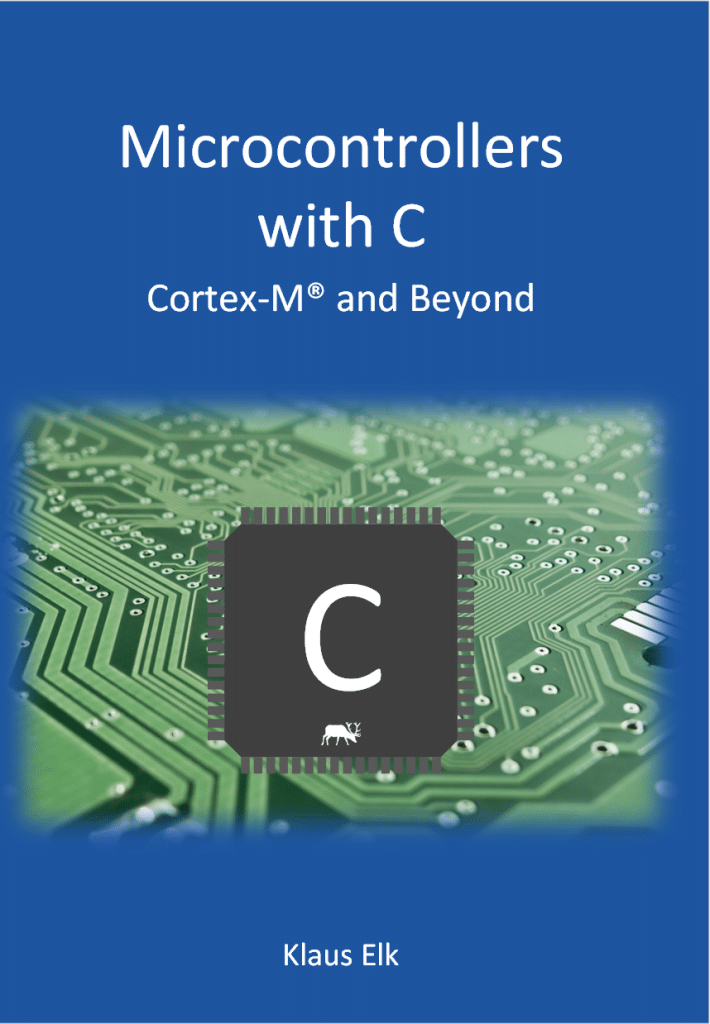
Back-Cover
The figure on the back of “Microcontrollers with C” is from the chapter on the “Generic Embedded System”. As described in the book, it shows the very common “Load-and-Store” architecture. It may also be seen as the Cortex-M architecture with its 16 registers – not showing barrel-shifter etc. I created this figure in Visio.
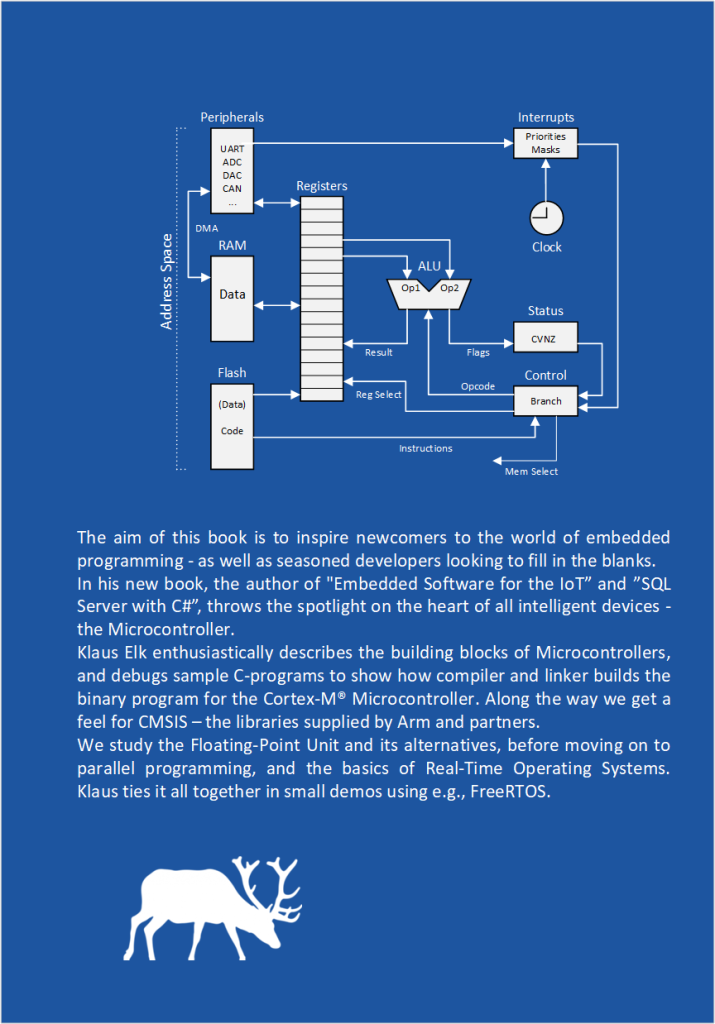
The Concept
“Microcontrollers with C” introduces the generic microcontroller and its building blocks – with threads back to older milestones like AMD’s Bit-Slice series, intel 8051 and also intel 8086 – even though the latter is a CPU – not a microcontroller.
As an example, modern Nucleo-64 boards from ST are introduced. We follow C-code through compiler and linker, via ELF to download and the Startup – finally bringing us to main(). Along the way we pickup a bit of assembly-language and learn about Arm specialties like the Literal Pools and how interrupt-routines can be written entirely in C.
A Tools chapter gives a brief overview of GUIs like Eclipse and Visual Studio Code, as well as Linker options etc.
Next, we dig into core subjects like exceptions, the stack-frame, branch instructions, and the Link-Register. We learn about CMSIS and how it makes life easier for the developer.
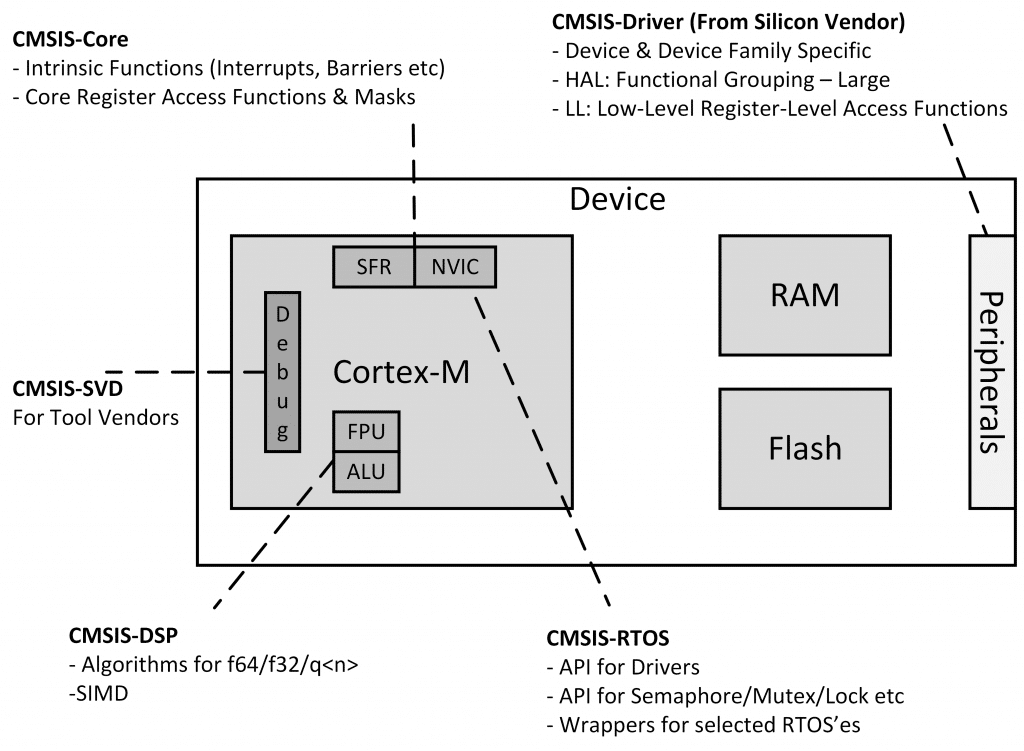
Moving on to the FPU (Floating-Point Unit), we compare this with fast integer-arithmetic, and see how fast RAM can be used for data as well as for code. We continue into a short study of the MPU (Memory-Protection Unit). Through all these subjects we study code – often with help from debuggers. Both Eclipse and Visual Studio Code are used in screenshots.
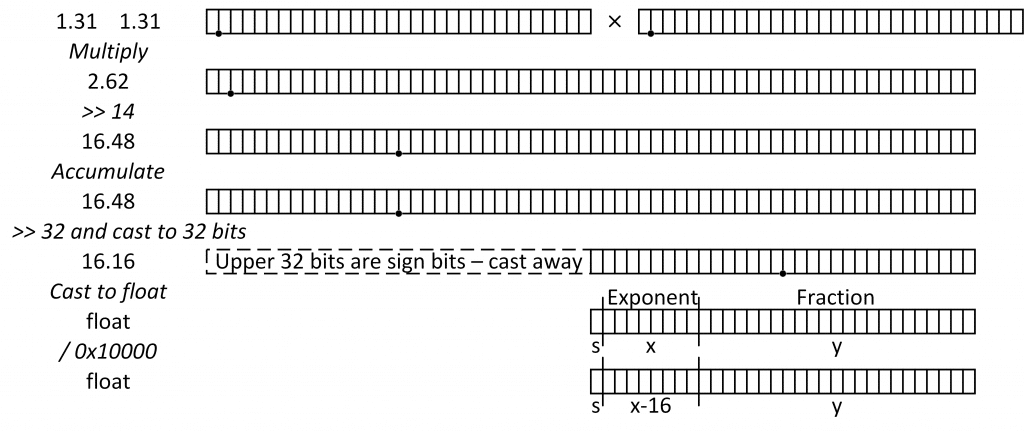
The remaining three chapters of the book dig into the workings of operating systems, introducing many patterns relevant for parallel programming. This leads to a FreeRTOS-based sample with Tasks, Interrupts, Semaphores and Queues (please see the page on Zephyr if ou want to see more on embedded OS’es).
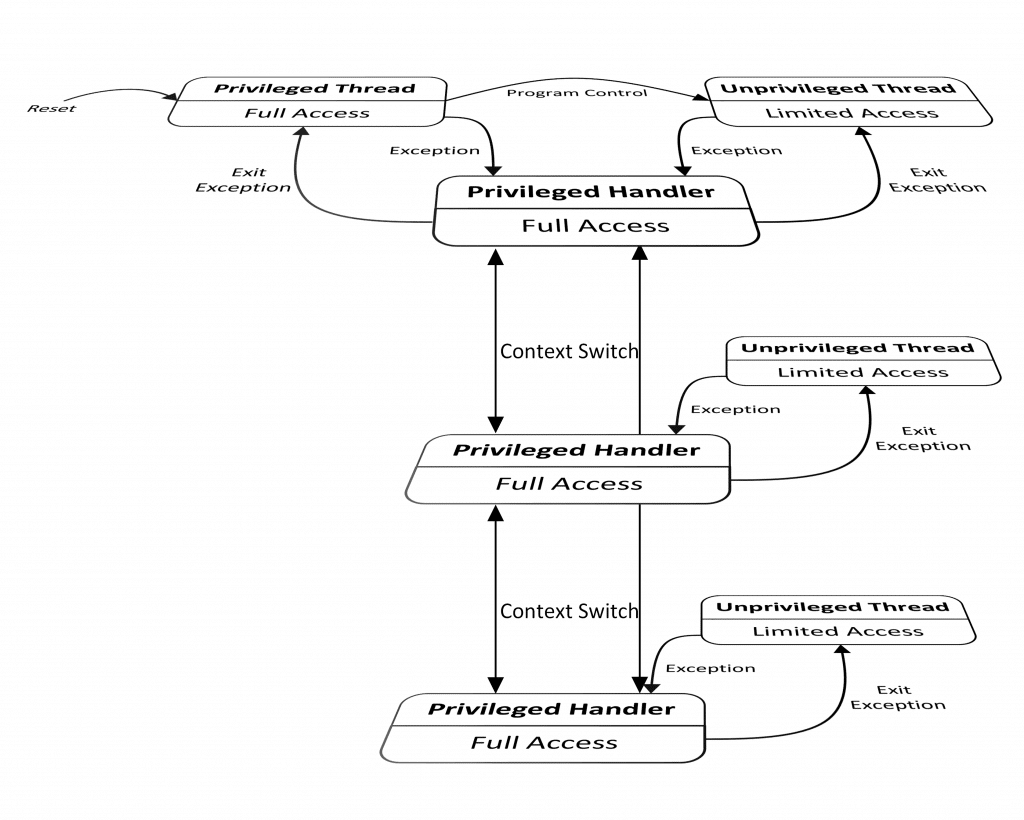
The technical stuff is spiced up a bit with personal experiences from older architectures. Including the story of how Diego Maradona came to my assistance 😉
There’s a rich index at the back of the book – making it easier to go back to things when you realize you need them 🙂
Please note that as the e-book is a replica of the text-book, the contents and index do not work as links.
You also find lists of Tables and Figures at the back.
Links
On Amazon, “Look Inside” is active on the kindle e-book, whereas on the paper-version you get the same functionality by pressing the button “Read Sample” below the cover-photo.
Please note that this book is only sold on Amazon. I have decided to keep the price very low, which means that there is no margin left for distributors and bookstores.
- Amazon Australia
- Amazon Brazil
- Amazon Canada
- Amazon France
- Amazon Germany
- Amazon India
- Amazon Japan
- Amazon Mexico
- Amazon Spain
- Amazon UK
- Amazon US
Table of Contents
1 Introduction
2 The Tip of the Iceberg
3 An Embedded System
3.1 Introduction
3.2 A Generic Embedded System
3.3 CPU and MCU
3.4 Harvard and Von Neumann
3.5 Physical Memory Types
3.6 The Cortex Families
3.7 STM32F334R8 Architecture
3.7.1 Buses
3.7.2 Analog Interfaces
3.7.3 Digital Interfaces
4 Memory and the Linker
4.1 Memory Map
4.2 Bit-Banding
4.3 Fast Memory Access
4.4 The Build Process
4.5 Memory Sections in C
4.6 Linker
4.7 Linker Script
4.8 Linker Map
4.9 ELF
4.10 Stack & Heap with monitors
5 C Startup
5.1 Reset Vector
5.2 Literal Pool
5.3 Startup Code
6 Toolchains and IDEs
6.1 Arm Compilers
6.2 Libraries
6.3 Building for FPU
6.4 Make
6.5 Compiler and Linker Options
6.6 IDEs and alternatives
7 Cortex-M Programmers Model
7.1 History of Cortex-M
7.2 Cortex-M Modes
7.3 Registers and Call Stack
7.4 Exceptions
7.5 Instructions
7.5.1 Program Status Register
7.5.2 Branches
7.5.3 Conditional Instructions
7.5.4 Exclusive Instructions
7.5.5 Barriers
7.6 Alignment
7.6.1 Single Words and Half-words
7.6.2 Structs
8 CMSIS & HAL
8.1 Overview of CMSIS
8.2 CMSIS-Core
8.3 CMSIS-Driver – Low-Level
8.4 CMSIS-Driver High-Level
9 Floating Point Unit & DSP
9.1 Working In Floating Point
9.2 Floating-Point Without FPU
9.3 Fixed Point
9.4 Executing in CCMRAM
9.5 Summing it all up
10 Memory Protection Unit
10.1 Stack Guard
11 Operating Systems
11.1 Multiple Thread Solutions
11.2 Context Switching Between Threads
11.3 Storing and Retrieving State
11.4 Executing the Context Switch
12 Common Patterns
12.1 Layering
12.2 State Machines
12.3 Blocking Threads vs Callbacks
12.4 Reentrant Code
12.5 Divide and Conquer
12.5.1 Heterogenous Tasks
12.5.2 Assigning Priorities
12.5.3 SIMD
12.5.4 Pipelining
12.5.5 Dedicated Subsystems
12.6 Message-Based System
12.7 Ring Buffers
12.8 Dynamic Memory
12.9 Synchronization Patterns
12.9.1 Critical Section
12.9.2 Lock
12.9.3 Mutex
12.9.4 Semaphore
13 FreeRTOS and STM32CubeMX
13.1 Initial FreeRTOS Setup
13.2 ITM and Printf
13.3 Messages Between Tasks
13.4 Interrupt with Semaphore
13.5 CMSIS-RTOS
List of Figures
List of Tables
Listings
Index
Datasheets and Manuals used when writing the book
161204_Mastering_the_FreeRTOS_Real_Time_Kernel-A_Hands-On_Tutorial_Guide.pdf
7563.ARM white paper – DSP capabilities of Cortex-M4 and Cortex-M7.pdf
an4838-introduction-to-memory-protection-unit-management-on-stm32-mcus-stmicroelectronics.pdf
apnt209__Faults.pdf
ARM-AN298-Lazy-stacking.pdf
Arm-Cortex-M-Comparison-Table-v9.pdf
arm_cortex_m33_dgug_100235_0100_05_en.pdf
Atmel-44045-32-bit-Cortex-M7-Microcontroller-Advanced-Debugging-SAM-V71-V70-E70-S70-MCUs-with-ARM-ETM_App-Note.pdf
CD00167594-Bootloaders.pdf
DDI0403E_e_armv7m_arm.pdf
DDI0439B_cortex_m4_r0p0_trm.pdf
DDI0440C_etm_m4_r0p1_trm.pdf
dm00314099-stm32h742-stm32h743-753-and-stm32h750-value-line-advanced-arm-based-32-bit-mcus-stmicroelectronics.pdf
DUI0553-Generic-User-Guide.pdf
en.DM00083249.pdf
en.DM00105879.pdf
en_HAL.DM00189702.pdf
nucleo-f334r8.pdf
pm0214-stm32-cortexm4-mcus-and-mpus-programming-manual-stmicroelectronics.pdf
pm0253-stm32f7-series-and-stm32h7-series-cortexm7-processor-programming-manual-stmicroelectronics.pdf
rm0364-stm32f334xx-advanced-armbased-32bit-mcus-stmicroelectronics.pdf
sprad27a.pdf
stm32f334r8.pdf
stm32h750xb.pdf
stm32wba52ce.pdf
swsy004e_TI.pdf
um1724-stm32-nucleo64-boards-mb1136-stmicroelectronics.pdf
um2217-description-of-stm32h7-hal-and-lowlayer-drivers-stmicroelectronics.pdf
um3103-stm32wba-nucleo64-board-mb1863-stmicroelectronics.pdf
um3128-getting-started-with-stm32cubewba-tfm-application-stmicroelectronics.pdf
